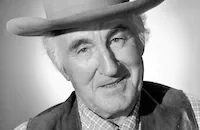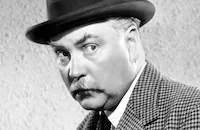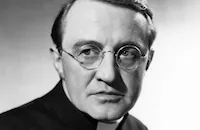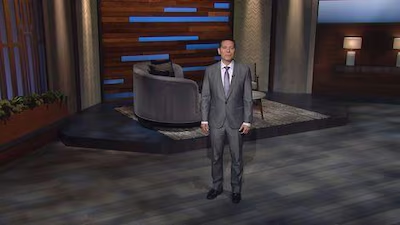Lassie Come Home

Brief Synopsis
Cast & Crew
Fred M. Wilcox
Roddy Mcdowall
Donald Crisp
Dame May Whitty
Edmund Gwenn
Nigel Bruce
Film Details
Technical Specs

Synopsis
Unaware that his poor, unemployed father Sam has been forced to sell his beloved collie Lassie to the Duke of Rudling, young Joe Carraclough, of Yorkshire, England, is immediately concerned when the dog fails to meet him, as usual, after school. When Sam and his wife Helen finally break the news, Joe is inconsolable. Lassie, meanwhile, is taken to the duke's kennels, where she is locked in a pen by Hynes, the cruel, Cockney dogkeeper. The next day, however, Lassie digs her way out of her pen and shows up at Joe's school at the usual time, four o'clock. Although Joe is overjoyed to see Lassie, his parents know that they must return her to the duke and reluctantly hand her over to Hynes. Lassie soon escapes a second time by jumping over the pen's fence. This time Joe runs off and hides with Lassie, but the two are quickly found by Sam, who insists that Joe return Lassie to the duke in person. At the duke's estate, Joe is somewhat cheered by the presence of Priscilla, the duke's sympathetic young granddaughter, who promises to give Lassie special care. That evening, Sam lectures Joe on the importance of honesty and informs his son that the duke is taking Lassie hundreds of miles away to Scotland for a dog show and will be staying there indefinitely. Later, in Scotland, Priscilla notices that Hynes has chained Lassie inside her pen and complains to her grandfather. The duke soundly chastises Hynes and orders him to walk Lassie around the estate's grounds. Hynes is so rough with Lassie, however, that the dog breaks away from him and dashes to the front gate, where Priscilla and the duke are standing. Priscilla opens the gate and allows Lassie to escape, then comments to her astounded grandfather that the collie is headed south, toward England. Lassie runs and runs until a rain storm forces her to take shelter. The next day, she resumes her journey and is almost killed by two shepherds, who suspect her of killing their sheep. After traversing a swampy area, Lassie then swims a river into England. Once in England, an exhausted, hungry Lassie collapses outside a cottage owned by Dally and Dan'l Fadden. Although the elderly couple eagerly adopt the dog, Dally soon realizes that Lassie, who whines to be let outside every afternoon at four, is not happy. Sensing that Lassie is anxious to continue her trek but is too "polite" just to go, Dally orders Lassie to leave the next day at four. Lassie takes off and eventually meets up with Rowlie Palmer, a tinker who travels with his little dog Toots. Lassie is cautious around Rowlie, but accepts his food and follows his wagon. Later, as Rowlie is selling his wares in a village, Lassie performs with Toots, doing tricks that Rowlie has taught her. That night at his camp, Rowlie is attacked by two roving thieves, Buckles and Snickers. Both Toots and Lassie help Rowlie in the fight, and when Buckles mortally wounds Toots, Lassie unleashes all her fury on him. Although the crooks scamper away, Rowlie is crushed by Toots's death. Soon after, Rowlie parts with Lassie, sensing as the Faddens did, that she is on a special journey. Lassie then makes her way through a city and is pursued by two dog-catchers. To avoid capture, Lassie jumps from a warehouse window, injuring her leg. Despite exhaustion, hunger and lameness, Lassie perseveres until she arrives at the Carracloughs' cottage. Helen and the still out-of-work Sam are stunned to see Lassie, filthy and thin, but gladly welcome her home. Soon after, the duke and Priscilla drive up to the cottage, and Sam and Helen, now determined to keep Lassie, hide her. To their surprise, the duke offers Sam a job as his new dogkeeper, and Sam gratefully accepts. Lassie soon gives her presence away, but the duke and Priscilla pretend not to recognize her. Then, just before four o'clock, Lassie limps over to Joe's school for her long-awaited reunion. Upon seeing Lassie, Joe, who has never stopped yearning for his dog, runs to her side and gives her a joyous, tearful embrace. Sometime later, Joe and Priscilla enjoy a bike ride together, accompanied by Lassie and her sprawling litter of collie puppies.

Director

Fred M. Wilcox
Cast

Roddy Mcdowall

Donald Crisp

Dame May Whitty

Edmund Gwenn

Nigel Bruce

Elsa Lanchester

Elizabeth Taylor
Ben Webster
J. Patrick O'malley

Alan Napier

Arthur Shields
John Rogers
Alec Craig
Lassie
Roy Parry
George Broughton
John Power
Nelson Leigh
Hugh Harrison
May Beatty
Janet Littlewood
Sherlee Collier

Charles Irwin
Crew
Daniele Amfitheatrof
Tom Andre
Charles Boyle
Hugo Butler
Jack Dawn
Cedric Gibbons
Mildred Griffiths
Paul Groesse
Charles Hunt
Henri Jaffa
Natalie Kalmus
Ben Lewis
Samuel Marx
Warren Newcombe
Al Raboch
Harry Rapf
Douglas Shearer
Leonard Smith
Edwin B. Willis
George Yohalem

Photo Collections
Videos
Movie Clip




Trailer
Hosted Intro





Promo
Film Details
Technical Specs

Award Nominations
Best Cinematography
Articles
Lassie Come Home
Set in England, the story is about the loyal bond of friendship between the collie and the young boy; the pair is split apart when the dog is sold by her poor family to the wealthy Duke of Rudling and spirited far north to Scotland. With the aid of the Scottish Duke's daughter, Lassie escapes her new confines and travels hundreds of miles to be reunited with the overjoyed boy. Along the way, Lassie overcomes danger and peril with the aid of helpful strangers, played by Gwenn and Whitty. Gwenn, best known for his portrayal of Kris Kringle in Miracle on 34th Street (1947), often specialized in kindly but eccentric elderly men. Whitty, who had extensive stage and film credits, received Oscar nods for her work in Night Must Fall (1937) and Mrs. Miniver (1942). Playing the boy's father in the film, Crisp is noted for working on both sides of the camera as actor and director in his career, but is best remembered for his Oscar-winning performance in How Green was my Valley (1941). Lanchester, forever immortalized as the hair-raising title character in Bride of Frankenstein (1935), was also known in real life as Mrs. Charles Laughton. Bruce, who took a break from his recurring role as Watson in the Basil Rathbone Sherlock Holmes film series, appears as the Duke of Rudling.
The role of the Duke's daughter, Priscilla, was originally awarded to Maria Flynn, a young actress who had previously acted alongside McDowall. When the first side-by-side daily prints of the film came in, however, it was readily apparent that Flynn had grown a good head taller than McDowall: the part would have to be recast. Producer Samuel Marx recalled a conversation with an old wartime buddy, Francis Taylor, and contacted him regarding his young daughter, an aspiring actress. After a brief improvised scene, Elizabeth was cast in the role of the girl. In the humble beginnings of a superstar career, she was paid $100 per week; Lassie, on the other hand, received $250! Her big break would come the next year with the release of National Velvet (1944), a film that also featured Crisp in a supporting role. Taylor and McDowall became close friends during the shooting of Lassie Come Home, a friendship that would last until McDowall's death in 1998. The two child actors worked together again as adults in Cleopatra (1963) and McDowall, an accomplished photographer, conducted Taylor's photo shoot for her 1963 Playboy spread.
But back to the casting problems. In addition to replacing Maria Flynn with Miss Taylor in the role of Priscilla, there was a problem with the star canine; the original dog cast in the role of Lassie was having a bad hair day - every day! Filming was extending into the end of summer, and the animal was shedding ferociously - so much so that a replacement was sought. The filmmakers had insisted upon a female dog to play the part, so male contenders were relegated to stand-in and stunt dog responsibilities. One of these stunt dogs, Pal, performed so well that the decision was made to cast him in the starring role. But the fact that she was really a he was kept a secret by the publicity department.
The dog's owner and trainer, Rudd Weatherwax, employed a wide variety of techniques to cajole Lassie into performing for the camera. Favorite toys and treats dangled in a tantalizing fashion just off-camera helped to focus the animal's attention to the right directions, and rubber balls were attached to doorknobs to give the impression that the dog was opening doors. A piece of cork attached to a paw provided a limp when the action called for Lassie to be injured, and ice cream smeared on McDowall's face allowed for the sloppy dog kisses. In order to secure a canine expression of frustration, Lassie was given a command to stay but forced to watch the director, beyond the sight of the cameras, being pushed around by the crew.
Based on the success of Lassie Come Home, several Lassie films were released in the subsequent years, including Courage of Lassie (1946) that once again featured Elizabeth Taylor. The original Lassie was replaced a total of five times by direct descendants throughout the years. None of the replacements were female, causing Groucho Marx to quip, "Ever since the public found out that Lassie was really a male, they've been thinking the worst about Hollywood."
Producer: Samuel Marx
Director: Fred M. Wilcox
Screenplay: Hugo Butler, based on the novel by Eric Knight
Cinematography: Leonard Smith
Film Editing: Ben Lewis
Original Music: Daniele Amfitheatrof
Principal Cast: Roddy McDowall (Joe Carraclough), Donald Crisp (Sam Carraclough), Dame May Whitty (Dolly), Edmund Gwenn (Rowlie), Nigel Bruce (Duke of Rudling), Elsa Lanchester (Mrs. Carraclough), Elizabeth Taylor (Priscilla), Ben Webster (Dan'l Fadden), Alan Napier (Jock).
C-90m. Closed captioning. Descriptive video.
by Eleanor Quin

Lassie Come Home
Lassie Come Home on DVD
Set in England, the story is about the loyal bond of friendship between the collie and the young boy; the pair is split apart when the dog is sold by her poor family to the wealthy Duke of Rudling and spirited far north to Scotland. With the aid of the Scottish Duke's daughter, Lassie escapes her new confines and travels hundreds of miles to be reunited with the overjoyed boy. Along the way, Lassie overcomes danger and peril with the aid of helpful strangers, played by Gwenn and Whitty. Gwenn, best known for his portrayal of Kris Kringle in Miracle on 34th Street (1947), often specialized in kindly but eccentric elderly men. Whitty, who had extensive stage and film credits, received Oscar® nods for her work in Night Must Fall (1937) and Mrs. Miniver (1942). Playing the boy's father in the film, Crisp is noted for working on both sides of the camera as actor and director in his career, but is best remembered for his Oscar®-winning performance in How Green was my Valley (1941).
The role of the Duke's daughter, Priscilla, was originally awarded to Maria Flynn, a young actress who had previously acted alongside McDowall. When the first side-by-side daily prints of the film came in, however, it was readily apparent that Flynn had grown a good head taller than McDowall: the part would have to be recast. Producer Samuel Marx recalled a conversation with an old wartime buddy, Francis Taylor, and contacted him regarding his young daughter, an aspiring actress. After a brief improvised scene, Elizabeth was cast in the role of the girl. In the humble beginnings of a superstar career, she was paid $100 per week; Lassie, on the other hand, received $250! Her big break would come the next year with the release of National Velvet (1944), a film that also featured Crisp in a supporting role. Taylor and McDowall became close friends during the shooting of Lassie Come Home, a friendship that would last until McDowall's death in 1998. The two child actors worked together again as adults in Cleopatra (1963) and McDowall, an accomplished photographer, conducted Taylor's photo shoot for her 1963 Playboy spread.
But back to the casting problems. In addition to replacing Maria Flynn with Miss Taylor in the role of Priscilla, there was a problem with the star canine; the original dog cast in the role of Lassie was having a bad hair day - every day! Filming was extending into the end of summer, and the animal was shedding ferociously - so much so that a replacement was sought. The filmmakers had insisted upon a female dog to play the part, so male contenders were relegated to stand-in and stunt dog responsibilities. One of these stunt dogs, Pal, performed so well that the decision was made to cast him in the starring role. But the fact that she was really a he was kept a secret by the publicity department.
The dog's owner and trainer, Rudd Weatherwax, employed a wide variety of techniques to cajole Lassie into performing for the camera. Favorite toys and treats dangled in a tantalizing fashion just off-camera helped to focus the animal's attention to the right directions, and rubber balls were attached to doorknobs to give the impression that the dog was opening doors. A piece of cork attached to a paw provided a limp when the action called for Lassie to be injured, and ice cream smeared on McDowall's face allowed for the sloppy dog kisses. In order to secure a canine expression of frustration, Lassie was given a command to stay but forced to watch the director, beyond the sight of the cameras, being pushed around by the crew.
Based on the success of Lassie Come Home, several Lassie films were released in the subsequent years, including Courage of Lassie (1946) that once again featured Elizabeth Taylor. The original Lassie was replaced a total of five times by direct descendants throughout the years. None of the replacements were female, causing Groucho Marx to quip, "Ever since the public found out that Lassie was really a male, they've been thinking the worst about Hollywood."
The Warner Video DVD of Lassie Come Home is a welcome though not particularly stunning addition to their library of Technicolor MGM classics not previously available on disc. Compared to the company's past releases of The Adventures of Robin Hood and Meet Me in St. Louis, the colors aren't as eye-popping or vivid and there are some obvious though minor flaws in the image - scratches and nicks. Yet, it's a completely respectable presentation if you don't compare it to Criterion's exacting standards. As for the modest extras, they include a collection of trailers from other MGM Lassie movies and Fala, a short subject on President Roosevelt's dog, a Scottish terrier.
This title is currently unavailable.
To order Lassie Come Home as part of TCM's Greatest Classic Films Collections, click here and here.
by Eleanor Quin
Lassie Come Home on DVD
Quotes
You might as well know it right off. Lassie won't be meeting you at school. She's been sold.- Mrs. Carraclough
You can't feed a dog on the dole, and you can't feed a family either.- Sam Carraclough
Trivia
Notes
The film's opening credits include the following written dedication: "The author of Lassie Come Home was a man of two countries. Born in England, he survived the First World War as a British soldier, only to die in the Second World War, killed in line of duty in the uniform of the country he had adopted...America. With reverence and pride, we dedicate this picturization of his best-loved story to the late Major Eric Knight." A brief, voice-over narration, describing "the people of Yorkshire," then accompanies the film's opening shots. Knight's novel was derived from a short story, which was published in The Saturday Evening Post on December 17, 1938. In the opening credits, Lassie is listed in two separate cast lists, seventh in the first list, and fourteenth in the second. Lassie, whose real name was Pal, made his screen debut in the picture and was selected for the role after M-G-M launched a nationwide talent hunt. (One Hollywood Reporter news item claimed that the studio was searching "back alleys" for a dog that used to sit in front of Dave Chasen's or the Brown Derby and beg for pennies.) According to modern sources, after the mass casting call failed to produce a viable dog star, M-G-M called in noted dog trainer Rudd Weatherwax. Although Weatherwax showed off many mature, purebred collies, one-year-old Pal, who lacked pedigree papers, easily won the role.
Lassie Come Home was the first entry in a six-picture series produced by M-G-M. The second, the 1945 Son of Lassie , was a sequel to Lassie Come Home, and featured Pal in the role Lassie, as well as Lassie's son "Laddie." In the sequel, the characters played by Roddy McDowall and Elizabeth Taylor in Lassie Come Home were performed by adult actors Peter Lawford and June Lockhart. (Lawford and Lockhart also played adult versions of the McDowall and Taylor characters in M-G-M's 1944 film The White Cliffs of Dover.) Lassie is the central character in all of the films, but only Lassie Come Home and Son of Lassie feature characters from the novel. Settings and time periods also change from picture to picture. Pal's four male descendents, all of whom were billed under the name Lassie, portrayed the collie in the other pictures. (Pal retired at the age of five, according to modern sources.) Elizabeth Taylor starred in the third film in the series, Courage of Lassie, but her role was unrelated to the part she played in Lassie Come Home. Edmund Gwenn and Donald Crisp appeared in two of the non-sequel entries. The last film in the series was The Painted Hills (1951), starring Gary Gray and directed by Harold Kress. Modern sources note that in the late 1940s, the number of purebred collies registered in the U.S. increased from 3,000 to 18,400, presumably as a result of the series.
Fred M. Wilcox, a former M-G-M publicist, script clerk, assistant director and second unit director, made his feature directing debut with this picture. Wilcox also directed two other films in the "Lassie" series, The Courage of Lassie and Hills of Home. McDowall and Donald Crisp had previously appeared together in the popular 1941 picture How Green Was My Valley . Lassie Come Home marked the first time in which Dame May Whitty and her husband, Ben Webster, who had just celebrated their golden wedding anniversary, appeared together in an American film. Reginald Owen was announced as a cast member in a September 1942 Hollywood Reporter news item, but he did not appear in the completed film.
Though not her debut film, Lassie Come Home was Taylor's first film for M-G-M, the studio at which she worked for the next seventeen years. Modern sources note that there are two versions about how the eight-year-old Taylor won the part of "Priscilla." In one version, confirmed by an October 1942 Hollywood Reporter news item, Taylor was "discovered" by producer Sam Marx when she brought sandwiches to her father, Francis L. Taylor, while he was on air raid warden duty with Marx. At the time, according to modern sources, Marx was looking desperately for a young actress with a convincing English accent because the girl he had originally cast as Priscilla had grown almost a foot and was noticeably taller than McDowall. According to the second version, the original Priscilla was let go because her eyes were too weak to withstand the bright lights on the set, and was replaced by Taylor after Marx and Wilcox contacted her agent, Sara Taylor. Taylor's dark beauty and natural acting made an immediate, strong impression on Marx and Wilcox, and many reviewers commented favorably on her performance. Taylor and McDowall were again cast opposite each other in the 1944 M-G-M picture The White Cliffs of Dover .
According to Hollywood Reporter news items, in addition to Southern California locations in Laguna Beach, Malibu, Chatsworth, Lake Arrowhead, Big Bear, Calabasas and Irvine Park in Santa Ana, some scenes and background shots were filmed in Santa Barbara, the San Joaquin River near Stockton and Monterey, CA, as well as Seattle and other parts of Washington State. Background shooting took place for two months, between July and August 1942. The Technicolor company experimented with a new "monopack" color process on this picture, according to an April 1944 Hollywood Reporter news item. The monopack process, in which all the color emulsions were present on one base and required no special cameras, replaced Technicolor's three-strip process. Smith was nominated for an Academy Award for Best Cinematography (Color). Redbook magazine named Lassie Come Home its "Picture of the Month" for October 1943.
In addition to the M-G-M film series, a "Lassie" radio show was broadcast on the ABC network between 1947 and 1950, featuring the barking of the original Pal, but with other sound effects provided by a human actor. On September 12, 1954, the CBS network broadcast the first episode of Lassie, a television show based on Knight's characters. Set in the U.S., the television Lassie lived first with a boy named "Jeff Miller," played by Tommy Rettig, and his mother, played by January Clayton. From 1957 to 1964, an orphan boy named "Timmy," played by Jon Provost, became Lassie's co-star, and Cloris Leachman and June Lockhart played his adopted mother in turn. The CBS show ran until summer 1971, and in fall 1971, a syndicated series called Lassie and Timmy began its three-year run. Between September 1973 and August 1975, an animated series, Lassie's Rescue Rangers, was broadcast on CBS. A second syndicated series, starring Will Nippen and featuring Jon Provost as the grown-up Timmy, was broadcast between 1989 to 1991. In 1963, Twentieth Century-Fox released the Wrather Corp. production Lassie's Great Adventure, a feature made from a four-part episode of the CBS series called "The Journey."
In 1953, Andrew Marton directed Donna Corcoran and Ward Bond in Gypsy Colt, M-G-M's second version of Lassie Come Home, in which the dog role was rewritten for a horse. (A television series based on Gypsy Colt, also called Gypsy Colt, aired on the ABC network in 1967.) In 1978, Don Chaffey directed Lassie, Jimmy Stewart and Mickey Rooney in the Wrather Corp.'s The Magic of Lassie. Knight's novel was adapted for the screen for a third time in 1994 as the Paramount production Lassie, directed by Donald Petrie and starring Thomas Guiry and Helen Slater. In 2006, another version of the story was released, the British-made Lassie, directed by Charles Sturridge, and starring Peter O'Toole and Samantha Morton. In all versions except the 2006 films, Lassie was played by one of Pal's descendents. For more information on the "Lassie" series, consult the Series Index. On AFI's 2003 list of the top 100 Heroes and Villains in American Films, Lassie was number thirty-nine on the list of heroes.
















